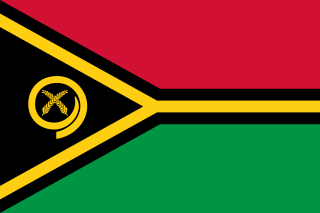
In Germanic mythology, Frigg, Frija, Frea (Langobardic), and Frige is a goddess. In nearly all sources, she is described as the wife of the god Odin. In Old High German and Old Norse sources, she is also connected with the goddess Fulla. The English weekday name Friday bears her name.
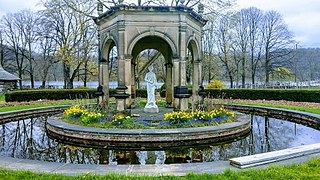
In Greek mythology, Harmonia is the immortal goddess of harmony and concord. Her Roman counterpart is Concordia. Her Greek opposite is Eris, whose Roman counterpart is Discordia.

Latinus was a figure in both Greek and Roman mythology. He is often associated with the heroes of the Trojan War, namely Odysseus and Aeneas. Although his appearance in the Aeneid is irreconcilable with his appearance in Greek mythology, the two pictures are not so different that he cannot be seen as one character.

In Norse mythology, Sigmund is a hero whose story is told in the Völsunga saga. He and his sister, Signý, are the children of Völsung and his wife Hljod. Sigmund is best known as the father of Sigurð the dragon-slayer, though Sigurð's tale has almost no connections to the Völsung cycle.
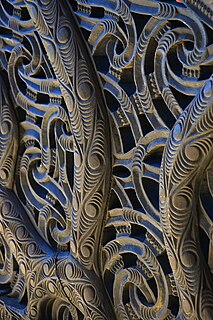
In Māori mythology, Tāwhaki is a semi-supernatural being associated with lightning and thunder.

Hindu mythology are narratives found in Hindu texts such as the Vedic literature, epics like Mahabharata and Ramayana, the Puranas, the regional literatures like Periya Puranam. Hindu mythology is also found in widely translated popular texts such as the Panchatantra and Hitopadesha, as well as Southeast Asian texts.

According to Hindu legends, Jamadagni is one of the Saptarishis in the seventh, current Manvantara. He is the father of Parashurama, the sixth incarnation of Vishnu. He was a descendant of the sage Bhrigu, one of the Prajapatis created by Brahma, the God of Creation. Jamadagni had five children with wife Renuka, the youngest of whom was Parashurama, an avatar of Lord Vishnu. Jamadagni was well versed in the scriptures and weaponry without formal instruction.

Parvati or Gauri is the Hindu goddess of fertility, love, beauty, marriage, children, and devotion; as well as of divine strength and power. She is the Jaganmata. Known by many other names, she is the gentle and nurturing aspect of the Supreme Hindu goddess Adi Parashakti and one of the central deities of the Goddess-oriented Shakta sect. She is the Mother goddess in Hinduism, and has many attributes and aspects. Each of her aspects is expressed with a different name, giving her over 100 names in regional Hindu stories of India. Along with Lakshmi and Saraswati, she forms the trinity of Hindu goddesses (Tridevi).

In Irish mythology, Ethniu, or Eithne in modern spelling, is the daughter of the Fomorian leader Balor, and the mother of Lugh. She is also referred to as Ethliu, genitive Eithlionn, dative Ethlinn.
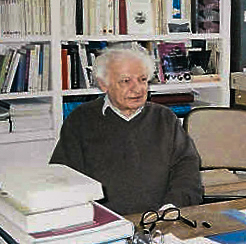
Yves Jean Bonnefoy was a French poet and art historian. He also published a number of translations, most notably the plays of William Shakespeare which are considered among the best in French. He was professor at the Collège de France from 1981 to 1993 and is the author of several works on art, art history, and artists including Miró and Giacometti, and a monograph on Paris-based Iranian artist Farhad Ostovani. The Encyclopædia Britannica states that Bonnefoy was ″perhaps the most important French poet of the latter half of the 20th century.″
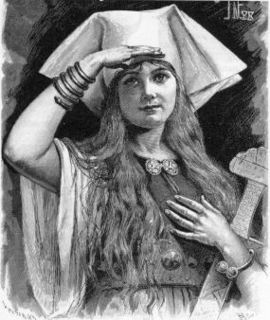
Svanhild is the beautiful daughter of Sigurd and Gudrun in Germanic mythology, whose grisly death at the hands of her jealous royal husband Ermanaric was told in many northern European stories, including the Icelandic Poetic Edda, Prose Edda and the Volsunga Saga; the Norwegian Ragnarsdrápa; the Danish Gesta Danorum; and the German Nibelungenlied and Annals of Quedlinburg.
Apsat was a male deity of birds and animals in the mythology of the peoples of the Caucasus of Georgia. His name may come from the Abkhaz language word a-psaåf, meaning "bird", or possibly from the name of the Christian saint with whom he was popularly associated, Saint Eustathios. Some sources regard him as responsible for all hunted game, while others consider him to watch over fish and birds specifically. In some cycles, he is the primary hunting deity, while in others, he is part of a pantheon of hunting deities. A few sources connect him with thunder and lightning.
Nevinbimbaau is a goddess in the Melanesian mythology of Malekula Island, Vanuatu. Some descriptions call her an ogress while others seem to speak of her as simply a female figure. Her rituals involve a complicated story about her son Mansip, his two wives and their children, Nevinbimbaau's grandchildren. The ritual begins with actors operating large staffs topped with carved heads, like stick puppets, representing the grandchildren. In the course of the ritual, some or all of the temes are destroyed, new ones are created, and at the end wooden effigies of Mansip and his two wives are speared and burned. The ritual's purpose may have been to initiate new members, and may have something to do with reincarnation or resurrection, since new temes are created after the old ones are destroyed.
Albanian folk beliefs comprise myths and legends of the Albanians. Many of the characters in Albanian mythology are included in the Albanian Songs of the Frontier Warriors, the traditional cycle of Albanian epic songs.
Mathilde Bonnefoy is a French film editor and director who was nominated for an ACE Eddie Award for the editing of the film Run Lola Run (1998) and who won the award for editing the documentary Citizenfour (2014). She and her husband Dirk Wilutzky additionally served as producers of Citizenfour with its director Laura Poitras, and the three received the 2014 Academy Award for Best Documentary Feature.
Buga is a creator god and omnipotent highest power in the mythology of the Tungusic peoples.
The zana e malit is an Albanian mythological creature ("fairy of the mountain" in English), zana, or zanë (plural) of pre-Roman Paleo-Balkan origin. It is also similar to the Bardha. The Zana are thought to have observed the speeches at the League of Prizren at 1878.

Madhu Ambat,ISC is an Indian cinematographer. With a wide variety of films he is one of the most experienced cinematographers in the Indian cinema industry. He is quite well known for his work in films such as Amaram, Anjali, and Makaramanju. He currently resides in Chennai, Tamil Nadu. He has won the National Film Award for Best Cinematography thrice.

The Abzu or Apsu, also called engur, was the name for fresh water from underground aquifers which was given a religious fertilising quality in Sumerian and Akkadian mythology. Lakes, springs, rivers, wells, and other sources of fresh water were thought to draw their water from the abzu. In this respect, in Sumerian and Akkadian mythology it referred to the primeval sea below the void space of the underworld (Kur) and the earth (Ma) above.

